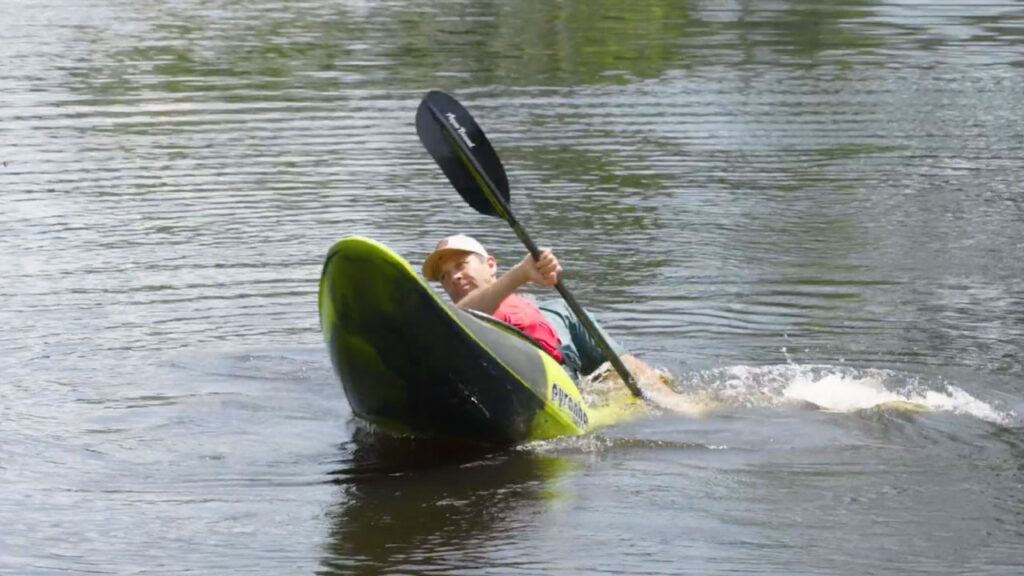Whitewater kayaking takes a lot of practice. So here are three good tips for whitewater kayakers that will help improve your whitewater skills. All whitewater kayakers should practice and master these three drills on flat water.
Carving Drill
Carving is an important skill for a variety of reasons. It is how you make solid and efficient eddy turns and good ferries. It also unlocks the door to many cool play moves like surfing waves. So it is invaluable for whitewater kayakers to learn to carve instead of letting the boat spin out.
How To Do the Carving Drill
First, you need to start kayaking and get some speed. Then you will establish turn momentum, put your kayak on edge, and use only forward strokes on the inside of your turn. Doing this keeps the kayak carving in a circle.

It is only possible to take strokes on the inside of a turn and keep going in the same direction if you do two things. The first thing is to keep the boat balanced on the edge. You do this by balancing on one butt cheek and fine-tuning the tilt using the opposite knee.

The second thing is to have the correct paddle position. Your paddle has to be vertical when you take a stroke. If the paddle shaft is more horizontal, it will kill your spin momentum. Because the paddle is vertical, you are not relying on it as a brace. It does not provide any balancing support, therefore, you have to rely on your own balance.
How to Apply Power
Once you become comfortable with that carving drill in both directions (which is important), you need to add power. I was once told that whitewater kayaking is all about technique and not power. There is some truth to that because good technique will take you a long way in the sport, while power alone will take you less far. But, as in any sport, you need good technique, but for that to be useful, you need to be able to apply power.

So how do you start applying power to the carving drill? Well, you need to get moving and carving again. The next step is to start pulling more aggressively on the paddle. With every stroke, you should thrust your hips forward. When you do this, you involve the whole body, which provides more power.
Application of the Carving Drill
You might recognize this as the boof stroke. It is the stroke you take when you go off a waterfall and thrust your boat over the lip. When you are boof off a waterfall, you need to hold your boat on edge. The last stroke before you go off the waterfall should be vertical so that you keep your boat straight. Boofing is just one of many applications of this stroke.
A more common application of the carving drill is in eddy turns. When you approach an eddy and want to cut into the main current, you need to paddle toward the eddy line with some speed. As you cross the eddy line, you should thrust the kayak across the line and into the main current to avoid getting spun.
Pivot Turns

This drill is intended for kayaks with a slicey stern, so half-slice sterns or playboats. It does not work in a creek boat.
So what are pivot turns? Pivot turns involve sinking one end of the kayak (usually the stern) under the water to make your kayak spin faster. Pivot turns are important to learn because they allow you to control your kayak's spin momentum. Whitewater kayaks are designed to turn, not to go straight, so you need to learn how to control the spinning momentum a whitewater kayak already has.
Pivot turns also allow you to harness the power of buoyancy energy. Buoyancy energy is the energy your kayak has any time the end of it is underwater. The end of your kayak does not want to stay underwater instead, it wants to come to the surface. You can use this to your advantage. Pivot turns also teach you edge control.

A Forward Sweep Pivot Turn
You can practice the pivot turn using a forward sweep and a backward sweep. To do a forward sweep turn, you should sink the stern of the kayak as you take a forward sweep.
Once the stern has been sunk, it doesn’t want to be underwater so, before the stroke is finished you have to level off the kayak. If you don’t level it off in time, the stern will “hit the wall” and pop back off to the surface.

If you do level the stern off in time, then it comes back to the surface in the direction you want it to come back in. This keeps your kayak spinning in full circle.
There are some useful things to note when doing a pivot turn. At the beginning of the stroke, you can be the most aggressive at throwing your stern downwards. As your stern goes further underwater, it has more and more buoyancy energy, so you start to lose power.

This is the point where you need to level your angle so that it is completely level by the time you finish your stroke. So you do not go directly from underwater to completely leveled in one go. Instead, you start as aggressively as possible and gradually level it off.
How to Practice the Pivot Turn
You can practice pivot turns in a variety of different ways. Firstly, you can practice it with a forward sweep, making sure to get comfortable with it on both sides. After all, you won’t only have to edge in one direction. You can also practice it with a back sweep. This is known as a stern squirt.
You could practice this on eddy lines, but it is better to practice on flat water. When doing pivot turns on flat water, you can see if and when you are doing something wrong. If you don’t level your boat off on time when on flat water, you will “hit the wall”, and lose all of the spin momentum you initiated.

Backpaddling
Backpaddling is a simple skill that is very important for multiple reasons.
1. It Develops Backpaddling Awareness
The more backpaddling practice you have, the more you develop your backpaddling awareness. The most likely time to panic is when you are turned backward while on a rapid. And the reason this can feel so scary is that most people have far more awareness when paddling forward than when facing backward. This awareness comes with practice and spending time going backward.
The biggest jump in my whitewater skills came one summer when a buddy and I decided to spend the entire month doing our regular paddles backward. We ran every rapid backward, caught every wave backward, and did everything we would normally do forwards, but backward instead. We were beaten and battered a few times, but our whitewater skills had improved massively by the end of the month.

I am not recommending that everyone should try this. But, there are less aggressive ways to practice backpaddling and develop your backpaddling awareness. For instance, when you get a nice eddy line, practice your eddy turns backward, practice your ferries backward, and if you are bold enough, you can even practice rapids backward.
2. It Works The Front Deltoid Muscles
Backpaddling works the front deltoids. The deltoids are muscles in your chest that you don’t often use when forward paddling. Working these helps to balance the body out when you do a lot of forward paddling.
Backpaddling Tips
When backpaddling, particularly with a slicey stern, it helps to keep your weight slightly forwards. If you tilt your kayak slightly into each backward stroke, it lifts your stern edges out of the water.
These are the three drills that all whitewater paddlers should practice regularly and master. Doing these three things regularly will have a profound effect on your whitewater kayaking.
The Pyranha Ripper 2
In this video I used the Pyranha Ripper 2 half slice whitewater kayak. This boat is a great river running kayak and is fun to play with as well on waves. Check out my review here: The Pyranha Ripper 2 Review: The Best All-Round Whitewater Kayak?

Kayak: Pyranha Ripper 2
PFDs/Life Jackets: NRS Zen Whitewater Vest
Paddle: Aqua Bound Shred
Shirt: NRS Guide Short Sleeved Men’s Shirt
Paddling Shorts: NRS Benny Board Shorts








